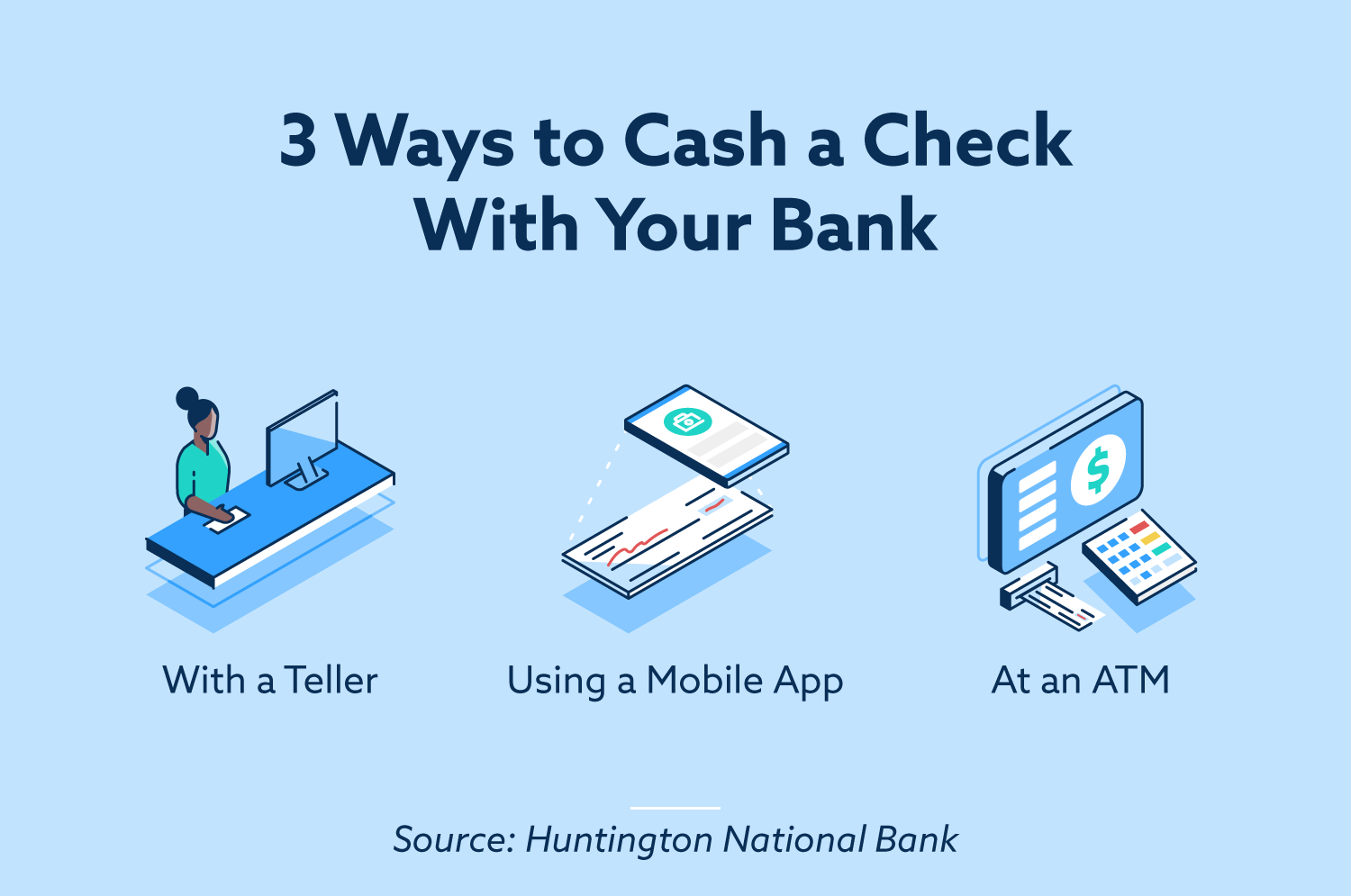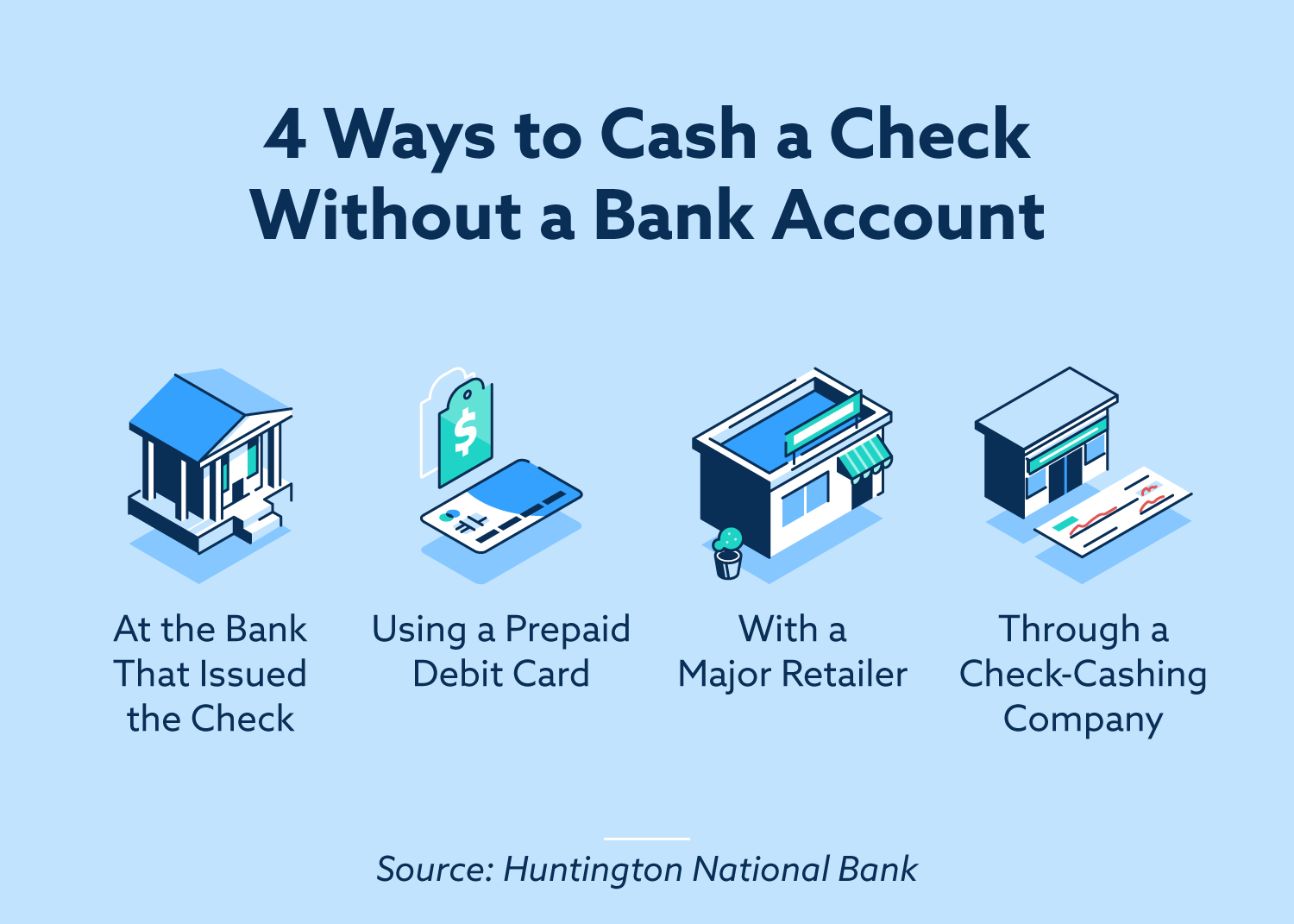
The information provided on this website does not, and is not intended to, act as legal, financial or credit advice. See Lexington Law’s editorial disclosure for more information.
You can cash a check by either depositing at your bank or bank’s ATM, using your bank’s mobile app, visiting the bank that issued the check, using a prepaid debit card or visiting a check-cashing company or major retailer that processes checks.
Whenever you get paid via check, you have two options: deposit the check into a bank account, or cash it out. Processing checks is a simple routine for many Americans. But what happens when you don’t have a bank account or you want to explore other options?
When deciding what to do with your check, you’ll want to choose a safe and affordable option, avoiding excess fees and charges. Here, we explain seven ways to cash a check—with or without a bank account:
- Deposit in person at your bank
- Deposit at your bank’s ATM
- Use your bank’s mobile deposit app
- Visit the bank that issued the check
- Use a prepaid debit card
- Cash out at a major retailer that processes checks
- Visit a check-cashing company
How to cash a check with your bank
Cashing a check at your bank is the simplest and most cost-effective way to get your money. You’ll avoid fees, and you may enjoy conveniences like being able to deposit the check online and in the comfort of your own home. There are three common ways to cash a check with your bank: in person, via the ATM or using mobile deposit with your bank’s app.

1. In person at your bank
If you have a checking account, the bank will cash out or deposit a valid check for you. The process is fairly simple—just be sure to verify the type of valid ID your bank accepts.
How to cash a check at your bank:
- Bring a valid ID: a driver’s license, passport, military ID or school ID may be accepted.
- Sign the back of the check in front of the teller (rather than beforehand) for maximum security.
- Present the check, your ID and a valid debit card to the teller, if requested.
2. Your bank’s ATM
If you’d prefer not to interact socially with a bank teller, most major financial institutions offer an ATM check deposit option as well. Depending on your bank, you may need to wait a few days for the check to process.
How to cash a check at an ATM:
- Insert your debit card into the ATM and enter your PIN, covering the keypad.
- Select the option to deposit a check, and insert your check into the slot as indicated.
- Confirm the amount of money on the check and wait for confirmation that it has been deposited.
3. Your bank’s mobile deposit app
Most major banks that have mobile apps now allow you to deposit checks via your smartphone. The specifics will vary by bank, but this process typically involves you taking a picture of the check and verifying the amount on it.
How to cash a check with mobile deposit:
- Endorse the check—this may require you to specify “mobile deposit only” on the back.
- Take a clear, well-lit photo of the check on a simple background like a tabletop.
- Wait a couple of business days until the check has cleared, and then be sure to shred it.
How to cash a check without a bank account
If you don’t have a bank account, there are still many different ways to cash a check. However, many of these come with hefty processing fees and fines. If you’ve recently received a check and have been considering opening a checking account, now is a great time to do so.
If a bank account isn’t for you at the moment, you can either cash it with the bank that issued the check, at a major retailer, using a prepaid debit card or—as a last resort—with a check-cashing company.
Keep in mind that if you don’t have an account with a certain bank or credit union, then they are not obligated to cash your check. According to the Consumer Financial Protection Bureau, they may often refuse to cash the check, especially if it’s more than six months old or if you don’t have proper identification.

4. Bank that issued the check
If you don’t have a bank account of your own, you may choose to cash your check with the bank that issued the check. You can find the name of the bank on the front of the check. You may be charged a fee—however, some states have laws that prevent banks and credit unions from charging you. The process is largely similar to that of cashing it with your own bank.
How to cash a check with the bank that issued it:
- Make sure to cash the check inside with a teller, as you won’t be able to use an ATM.
- Present a valid ID and endorsed check to the teller, along with a fee if necessary.
- Confirm that the account from which the check was written has sufficient funds—if not, the bank is not required to cash it.
5. Prepaid debit cards
Prepaid cards act like gift cards—you load money onto them, and any purchases you make come out of the card’s balance. Many cards allow you to deposit your checks via a mobile app or an ATM. However, these options typically charge a fee, in the form of either a percentage of the total check amount or a monthly service fee.
How to cash a check using a prepaid debit card:
- Deposit your check via ATM or mobile deposit through the institution that issued your prepaid card.
- Wait until the funds go through before making purchases with the card, unless your existing balance is enough to cover the transaction.
- Be on the lookout for fees and ensure you can pay them if needed.
6. Major retailers
Many large national grocer or retail chains offer check-cashing services for business, payroll and even personal checks. These typically come with lower fees than check-cashing companies or banks you don’t have an account with.
How to cash a check at a major retailer:
- Inquire if you’ll need to become a member of their rewards program or loyalty program before cashing, which is common and usually free.
- Endorse the check in front of the store employee.
- Present a valid ID, endorsed check and fee to the store employee.
7. Check-cashing companies
Check-cashing companies are firms that take a commission from all checks cashed, which can often be 10 percent or more. While convenient—you typically receive the cash immediately—this method is typically very expensive and should be used as a last resort.
How to cash a check with a check-cashing company:
- Inquire about fees up front so you know exactly how much you’ll be paying.
- Endorse the check in front of the store employee and present it along with an ID and fee.
- Receive the cash, double-counting to ensure the accurate amount.
Safety considerations
To ensure you’re staying safe and cautious when processing a check, consider the following before cashing or depositing it:
- Make sure the check is legitimate. If you receive a check in the mail that you weren’t expecting or don’t recognize, call the bank that issued it to verify the funds.
- Never endorse a check until the moment you’re ready to deposit or cash it out. If someone else gets ahold of the endorsed check, they may be able to cash it out.
- Never endorse a check with pencil, as it may be erased or modified.
- If a check is still in your possession after depositing it (like in the case of mobile deposit), keep it in a secure location until it has gone through—then destroy it.
- Always cover the keypad when entering your PIN at an ATM.
Whichever method you decide to use for cashing a check, make sure to shop around to find the best deal to ensure that you don’t end up paying unnecessary fines. As a general rule of thumb, cash the check as soon as possible to avoid a bounced check and the fees associated with it. If you’re unsure whether the person who issued the check can cover the funds, it may be worth asking them before attempting to cash out the check.
Checks don’t typically affect your credit—except if you issue a check for a loan payment and it bounces or returns marked as “insufficient funds.” In this case, you have 30 days to make the payment or else your credit score may take a hit. If you’ve experienced a credit score drop due to a bounced check that you believe may have been a mistake, consider exploring credit help options.
Note: Articles have only been reviewed by the indicated attorney, not written by them. The information provided on this website does not, and is not intended to, act as legal, financial or credit advice; instead, it is for general informational purposes only. Use of, and access to, this website or any of the links or resources contained within the site do not create an attorney-client or fiduciary relationship between the reader, user, or browser and website owner, authors, reviewers, contributors, contributing firms, or their respective agents or employers.
